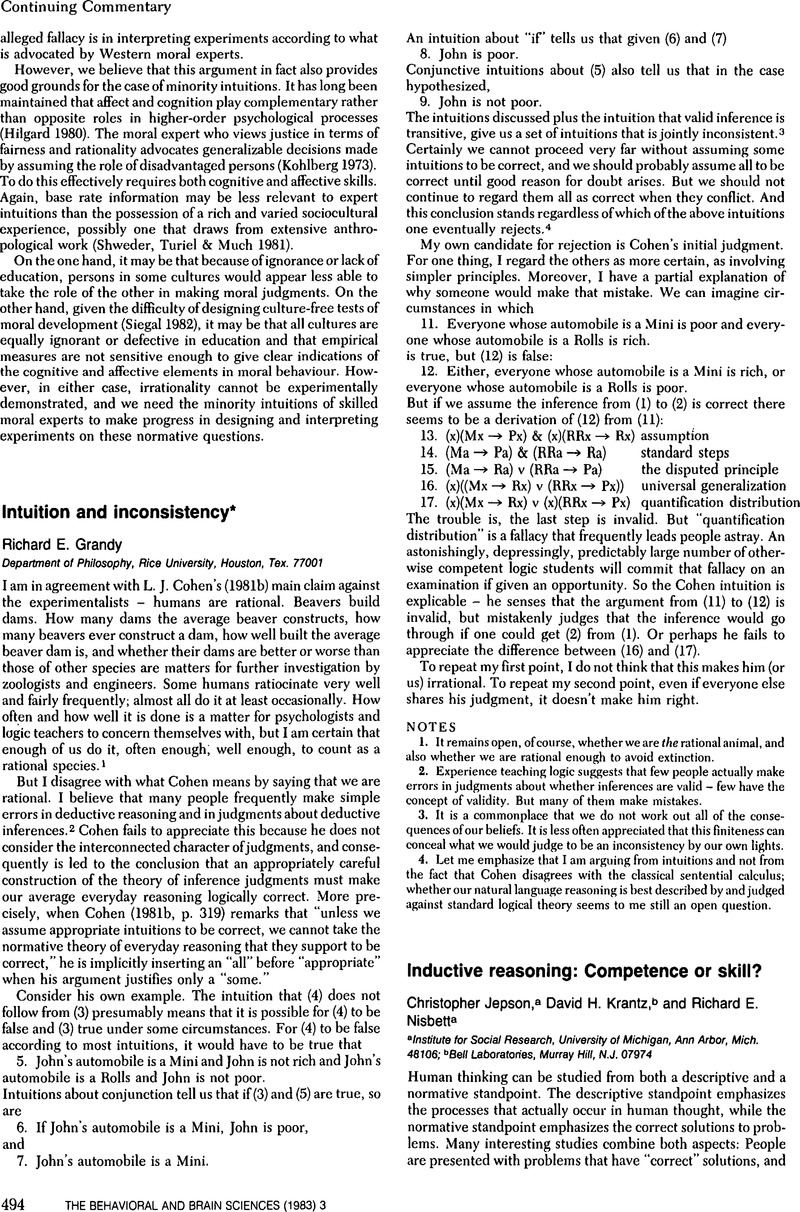Crossref Citations
This article has been cited by the following publications. This list is generated based on data provided by Crossref.
Morier, Dean M.
and
Borgida, Eugene
1984.
The Conjunction Fallacy.
Personality and Social Psychology Bulletin,
Vol. 10,
Issue. 2,
p.
243.
Cheng, Patricia W
Holyoak, Keith J
Nisbett, Richard E
and
Oliver, Lindsay M
1986.
Pragmatic versus syntactic approaches to training deductive reasoning.
Cognitive Psychology,
Vol. 18,
Issue. 3,
p.
293.
Kunda, Ziva
and
Nisbett, Richard E
1986.
The psychometrics of everyday life.
Cognitive Psychology,
Vol. 18,
Issue. 2,
p.
195.
Kunda, Ziva
and
Nisbett, Richard E
1986.
Prediction and the partial understanding of the law of large numbers.
Journal of Experimental Social Psychology,
Vol. 22,
Issue. 4,
p.
339.
Fong, Geoffrey T
Krantz, David H
and
Nisbett, Richard E
1986.
The effects of statistical training on thinking about everyday problems.
Cognitive Psychology,
Vol. 18,
Issue. 3,
p.
253.
Van Der Pligt, Joop
1988.
Applied decision research and environmental policy.
Acta Psychologica,
Vol. 68,
Issue. 1-3,
p.
293.
Kruglanski, Arie W.
1990.
Vol. 68,
Issue. ,
p.
15.
Smith, Edward E.
Langston, Christopher
and
Nisbett, Richard E.
1992.
The Case for Rules in Reasoning.
Cognitive Science,
Vol. 16,
Issue. 1,
p.
1.
Bisanz, Jeffrey
Bisanz, Gay L.
and
Korpan, Connie A.
1994.
Thinking and Problem Solving.
p.
179.
Shiloh, Shoshana
1994.
Applications of Heuristics and Biases to Social Issues.
Vol. 3,
Issue. ,
p.
13.
Gigerenzer, Gerd
1996.
Why do frequency formats improve Bayesian reasoning? Cognitive algorithms work on information, which needs representation.
Behavioral and Brain Sciences,
Vol. 19,
Issue. 1,
p.
23.
Connolly, Terry
1996.
Are base rates a natural category of information?.
Behavioral and Brain Sciences,
Vol. 19,
Issue. 1,
p.
19.
Melone, Nancy Paule
and
McGuire, Timothy W.
1996.
Conservatism revisited: Base rates, prior probabilities, and averaging strategies.
Behavioral and Brain Sciences,
Vol. 19,
Issue. 1,
p.
36.
Klar, Yechiel
1996.
P(D/H), P(D/˜H), and base rate consideration.
Behavioral and Brain Sciences,
Vol. 19,
Issue. 1,
p.
26.
McLeod, Peter J.
and
Watt, Margo
1996.
How are base rates used? Interactive and group effects.
Behavioral and Brain Sciences,
Vol. 19,
Issue. 1,
p.
35.
Hamm, Robert M.
1996.
Physicians neglect base rates, and it matters.
Behavioral and Brain Sciences,
Vol. 19,
Issue. 1,
p.
25.
Fernandez-Berrocal, Pablo
Almaraz, Julian
and
Segura, Susana
1996.
How to reconsider the base rate fallacy without forgetting the concept of systematic processing.
Behavioral and Brain Sciences,
Vol. 19,
Issue. 1,
p.
21.
Margolis, Howard
1996.
Nuancing should not imply neglecting.
Behavioral and Brain Sciences,
Vol. 19,
Issue. 1,
p.
32.
Cohen, L. Jonathan
1996.
The need for a theory of evidential weight.
Behavioral and Brain Sciences,
Vol. 19,
Issue. 1,
p.
18.
McCauley, Clark
1996.
First things first: What is a base rate?.
Behavioral and Brain Sciences,
Vol. 19,
Issue. 1,
p.
33.



